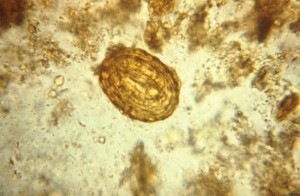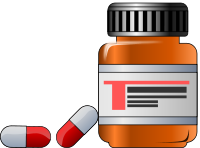The article is a continuation of basics of antihelminthics.
General Adverse Drugs Reactions of Antihelminthics
1. Intestinal Actions
Intestinal actions include nausea, vomiting, diarrhea, anorexia and abdominal pain
2. Allergic Reactions
When worms die in the intestine, proteins are released that are foreign to the body, leading to antigen antibody reaction. This results in allergic response including skin rash, itching, pruritis, enlargement of lymph nodes, arthralgia, fever and blood dyscrasias (eosinophilia, leukopenia, agranulocytopenia) etc.
3. CNS
CNS symptoms include headache, dizziness, drowsiness and vertigo.
Image courtesy of CDC
Piperazine Citrate
Piperazine citrate is the oldest drug used for worm infestation. Chemically it is a piperazine derivative available in the form of hexahydrate.
Mechanism of Action
- It decreases the response to acetylcholine by muscles of worm, leading to decreased action of acetylcholine on neuromuscular junction. This leads to decreased contraction and flaccid paralysis. Thus the worm is unable to maintain its position in the gut and is expelled by normal peristalsis.
- It causes hyperpolarization by acting like GABA, leading to paralysis of muscles of worm.
Adverse Effects
- General toxicity (already explained)
- Specific toxicity:
- Convulsions
- Respiratory depression
- Lymphadenopathy
Contraindications
- Epilepsy
- Kidney failure (increased chances of neurotoxic effects)
It is safer in pregnancy.
Uses
- Ascariasis (75 mg/kg TD for 2 days)
- Oxyuriasis (65 mg/kg for 7 days)
Dose
- Tablets (250 mg)
- Suspension (100 mg/ml)
Diethylcarbamazine
It is a piperazine derivative.
Mechanism of Action
The mechanism of action is same as that of piperazine citrate. Additional actions include:
- Changes in skin (tegument) of parasites, making them more vulnerable to host defense mechanism.
- Interferes with macromolecules transport across membranes of parasites.
Pharmacokinetics
- Rapid oral absorption
- Half life is 2-3 hours in acidic urine. It is 10 hours in alkaline urine
- Unchanged drug and N-oxide metabolites are excreted in urine
- The dose has to be decreased in patients of urinary alkalosis and renal impairment
Adverse Effects
- General (already explained)
- Specific
- Ocular changes including keratitis, uveitis and changes in retinal pigments
- Lymphadenopathy; localized swelling in W. bancrofti and W. malayi, small wheals in skin in L. loa and flat papules in M. streptocerca infection
- Proteinuria (due to release of proteins from dying microfilarae)
- Encephalitis
- Leukocytosis
- Allergic reaction to dying microfilarae, which is mild in W. bancrofti, intense in W. malayi and severe in L. loa
Contraindications
Children under 2 years of age. It is safe in pregnancy
Uses
- Effect against microfilarae (developmental forms of parasites in blood) leading to disappearance of microfilarae)
- Used against W. bancrofti, Brugia malayi, Loa loa, for which it is the drug of choice. It is also effective against Onchocercus volvulus, but now has been replaced by Ivermectin.
- Used prophylactically for loa loa, Bancrofti and Malayan filariasis
- Tropical eosinophilia, for which it is given orally
- Mansonella streptocerca; effective against adults and microfilarae
Dose
- For W. bancrofti 2 mg/kg for 5-7 days
- For Loa loa 2 mg/kg for 2-3 weeks
 howMed Know Yourself
howMed Know Yourself





